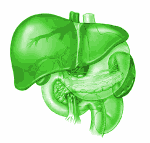Natural history of HCV

- What does your liver do?
- How does HCV damage your liver?
- HCV outside of the liver
- Natural history of HCV
- Recently acquired HCV
- Chronic infection
What does your liver do?
Your liver is an essential organ that does hundreds of things.
These include:
- Filtering chemicals and waste from the blood.
- Storing vitamins, minerals and iron and converting nutrients from food into energy.
- Helping to balance levels of sugar and hormones.
- Producing cholesterol.
- Making bile (needed for digestion), and creating the hormone that helps to produce platelets (to stop bleeding).
How does HCV damage your liver?
HCV does not directly damage your liver.
It is the way that the immune system reacts to the virus that causes liver inflammation.
As the immune system attempts to surround and isolate infected cells to protect the liver, scarring develops and worsens.
As the liver becomes more scarred it hardens, making it more difficult for blood and other fluids to flow through it.
Even though the liver can still work when it is damaged, the continuous effect of HCV can slowly interfere with liver function. Complications develop when the liver is too damaged to be able to carry out important tasks.
Without treatment, HCV is linked to a long list of serious complications, although many of these only occur in late stage infection.
HCV outside of the liver
As with HIV, HCV increases the risk for other health problems, including type 2 diabetes, kidney and heart disease, and bone loss.
The reasons for this include inflammation from untreated HCV, long-term use of some HIV drugs, family history and lifestyle.
For people with coinfection, being cured from HCV lowers the risk for liver-related illness and death, AIDS-related illness and death, and type 2 diabetes.
Natural history of HCV
The natural history of an infection is the term for describing what happens if the infection is not treated.
The natural history of HCV infection includes three possible stages:
- Recently acquired infection.
- Chronic infection.
- End stage liver disease (ESLD).
Recently acquired HCV
Recently acquired HCV refers to the first 12 months after HCV infection.
Unless it causes symptoms recently acquired HCV is rarely diagnosed. Symptoms only occur in 1 in 5 people and can include fever, fatigue, abdominal pain, nausea, vomiting, dark urine, pale faeces and jaundice.
In people living with HIV, recently acquired HCV is generally diagnosed due to routine monitoring on ART. One sign of recently acquired HCV is very high liver enzymes, sometimes 10 times higher than normal. This should prompt checking for recently acquired HCV.
Gay men living with HIV should have an annual screen for HCV, and be tested if they have been at risk.
People who have cleared HCV or been cured by treatment should be screened using an HCV RNA viral load or HCV core antigen test.
In the first months of infection, some people clear HCV without treatment.
This is called spontaneous viral clearance. It is more common if:
- You had symptoms during recently acquired HCV.
- You are female.
- You are under 40 years old.
- You have certain genes.
- Your CD4 cell count is high.
People living with HIV are only half as likely to spontaneously clear HCV as HIV negative people.
People of African descent are less likely to clear HCV than Caucasians.
Genetics are part of the reason for these differences, but other factors are also involved.
People who clear HCV without treatment are no longer infectious. They usually test positive from an HCV antibody test, but HCV will not be detectable in blood.
Chronic infection
Chronic infection refers to any time after recently acquired infection (the first 12 months after infection).
In HIV negative people, untreated HCV usually progresses very slowly, often over decades.
Some people never develop serious liver damage or symptoms. But most people will have mild to moderate liver scarring (fibrosis) or symptoms such as fatigue, depression and confusion. Untreated HCV can also cause other health problems.
HIV increases the risk for, and speeds up the rate of liver damage from HCV.
It is important to be treated before serious liver damage develops.
Treating (and curing) HCV before HCV causes serious liver damage prevents liver failure and liver cancer.
People with cirrhosis need to be treated by a liver specialist. Although DAAs do not work as well for people with cirrhosis, the cure rate is at least 80%.
The risk for liver cancer remains high for people with cirrhosis, even after being cured and requires continued screening.
Last updated: 1 November 2024.
